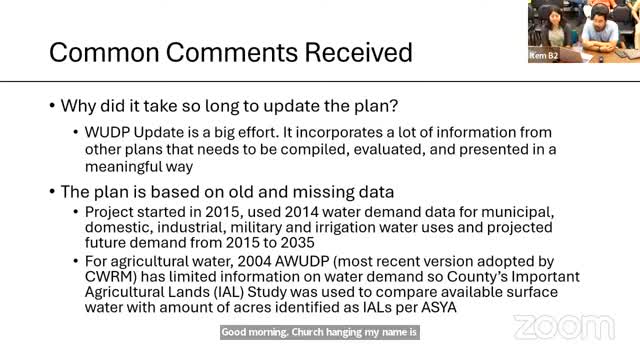Water Department Faces Community Scrutiny Over Development Delays
September 17, 2024 | Water Resource Management, Commission on, Executive , Hawaii
This article was created by AI summarizing key points discussed. AI makes mistakes, so for full details and context, please refer to the video of the full meeting. Please report any errors so we can fix them. Report an error »

In a recent government meeting, the acting head of the engineering division highlighted the importance of community engagement in the development of the Water Use and Development Plan. The division has been actively seeking public feedback, which has proven to be a valuable learning experience, allowing officials to better understand community needs and expectations.
The discussion revealed concerns regarding the prolonged timeline of the project, which began approximately ten years ago. The division acknowledged that the last adopted development plan dates back to 1990, emphasizing the necessity for updates to reflect current demands and conditions. The team is motivated to advance the project, which involves consolidating and evaluating four significant plans to present a comprehensive and understandable proposal to the public.
Addressing criticisms about outdated data, officials clarified that the plan is based on projections from 2014, extending to 2035. They assured that the projections consider full build-out scenarios based on zoning and planning, rather than solely population estimates. The division also noted that while the current plan lacks specific agricultural water use data, future updates will incorporate more detailed demand information.
Another key point raised was the need to consider traditional and customary water practices in the planning process. The division committed to reviewing these practices during future permit applications, ensuring that cultural considerations are integrated into water management strategies.
Overall, the meeting underscored the division's commitment to transparency and responsiveness to community feedback as they work towards a more effective and inclusive water management plan.
The discussion revealed concerns regarding the prolonged timeline of the project, which began approximately ten years ago. The division acknowledged that the last adopted development plan dates back to 1990, emphasizing the necessity for updates to reflect current demands and conditions. The team is motivated to advance the project, which involves consolidating and evaluating four significant plans to present a comprehensive and understandable proposal to the public.
Addressing criticisms about outdated data, officials clarified that the plan is based on projections from 2014, extending to 2035. They assured that the projections consider full build-out scenarios based on zoning and planning, rather than solely population estimates. The division also noted that while the current plan lacks specific agricultural water use data, future updates will incorporate more detailed demand information.
Another key point raised was the need to consider traditional and customary water practices in the planning process. The division committed to reviewing these practices during future permit applications, ensuring that cultural considerations are integrated into water management strategies.
Overall, the meeting underscored the division's commitment to transparency and responsiveness to community feedback as they work towards a more effective and inclusive water management plan.
View full meeting
This article is based on a recent meeting—watch the full video and explore the complete transcript for deeper insights into the discussion.
View full meeting
